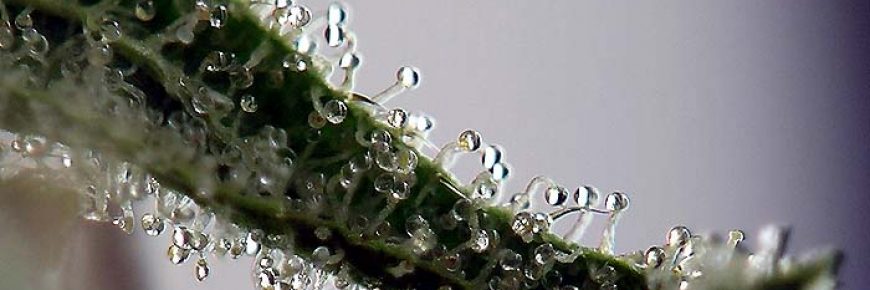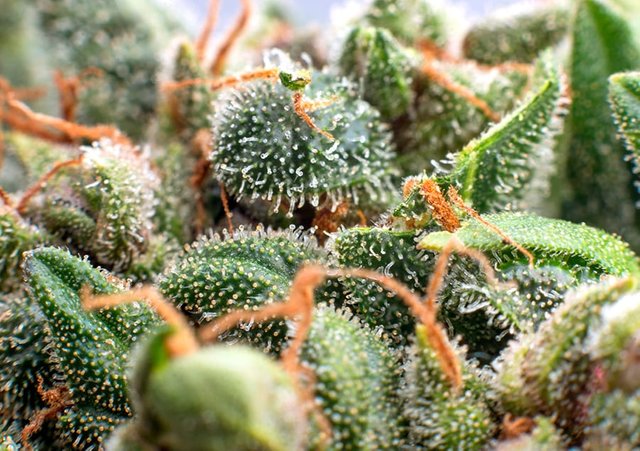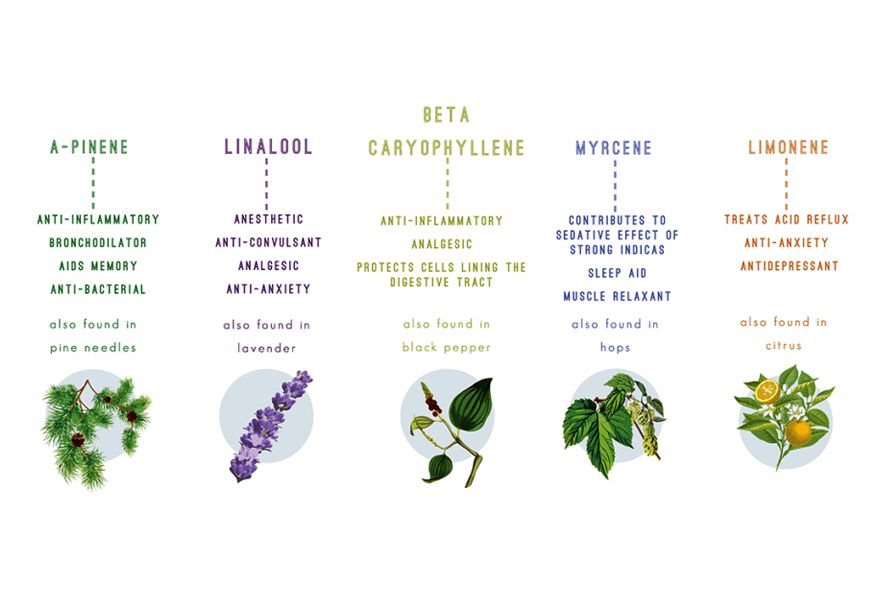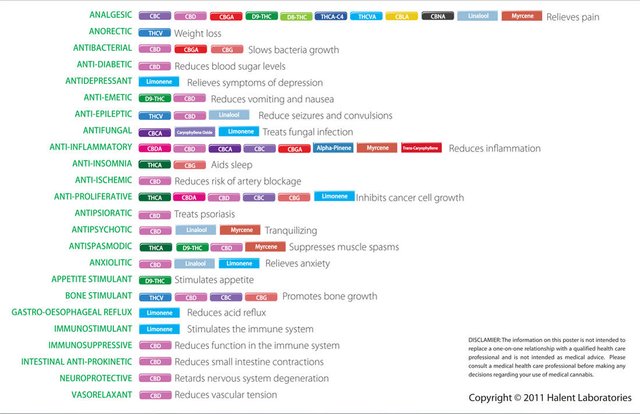Weed Wars: Which is Better- Cannabinoids or Terpenes?

In 1964, Dr. Raphael Mechoulam identified THC, the psychoactive compound in marijuana. It was the beginning of our understanding of the marijuana plant. However, weed’s Schedule I status under the 1970 Controlled Substances Act means research on cannabis has been significantly slower than it should have been.
CBD, the non-intoxicating compound in marijuana, is only a relatively recent study. It is one of over 100 cannabinoids in marijuana and is a major phytocannabinoid, as it accounts for around 40% of the cannabis plant’s extract. While most of our attention is focused on what THC and CBD can do, it is crucial to note that phytocannabinoids such as CBN, CBG, THCA, THCV, and many more, play an active role in the psychoactive and therapeutic effects of cannabis.
Then there is the small matter of terpenes; yet another class of active compounds in weed. Once again, research into terpenes is relatively recent; but we know they are responsible for the various alluring aromas and tastes of marijuana. Moreover, terpenes could also assist cannabinoids when it comes to providing medical benefits. In this piece, we analyze terpenes and see how they differ from cannabinoids.
What Are Terpenes & How Do They Help Us?

Classified as “volatile aromatic molecules,” terpenes evaporate easily which is one of the reasons why they produce marijuana’s noticeable scent. An estimated 200 terpenes have been found in cannabis although only a few dozen appear to exist in large enough quantities to be noticeable. Unlike cannabinoids, terpenes are also found in most vegetables and edible herbs.
You might also have heard people use the terms ‘terpenes’ and ‘terpenoids’ interchangeably but in reality, they have different meanings. Terpenes are hydrocarbons (carbon and hydrogen are the only elements present), whereas terpenoids are denatured via oxidation (the flowers are dried or cured) or else they are chemically modified.
Terpenes are synthesized in marijuana’s secretory cells inside glandular trichomes, and exposure to light increases the rate of production. You will typically find high concentrations of terpenes in unfertilized marijuana flowers before they start to deteriorate with age. The essential oil is extracted via vaporization or steam distillation. Interestingly, a significant number of terpenes vaporize at approximately the same temperature as THC although some are far more volatile.
Terpenes are a crucial element of the cannabis plant which explains why there are so many of them! They offer natural protection against insects, fungi, and bacteria. Terpenes are also responsible for the smell of weed. They act on the body’s transmitters and neurotransmitters and are also serotonin uptake inhibitors in the same vein as Prozac and other anti-depressants. Other benefits include:
- Augmenting GABA which counters the ‘upper’ neurotransmitter known as glutamate.
- Enhancing norepinephrine activity in a manner akin to specific types of antidepressant.
- Increasing dopamine which is the neurotransmitter responsible for controlling the reward and pleasure centers of the brain.
Significant Terpenes in Cannabis

Although there are hundreds of identified terpenes, only a small proportion exist in amounts significant enough to have a therapeutic benefit. Below, we look at five important terpenes along with a brief description of how they can help you.
1 – Myrcene
This is the most prevalent terpene in weed; some strains contain up to 60% of the essential oil. If you’ve ever experienced ‘couch lock,’ it means you’ve consumed cannabis with at least 0.5% myrcene. Potential medicinal benefits include allowing the effects of cannabinoids to act faster and inhibiting gastric and duodenal ulcers.
2 – Limonene
This is one of two compounds formed from Pinene, and its strong citrus smell gives it the Limonene name. It appears rapidly in the bloodstream and suppresses the growth of various fungi and bacteria species.
3 – Pinene
Once again, this is a well-named terpene as Pinene gives off a distinctive pine and fire aroma. It is used as an anti-inflammatory, and interestingly, Pinene has been used as an anti-cancer agent in Traditional Chinese Medicine for decades. As an aside, China’s once-low rate of cancer is growing now that it is becoming more industrialized and dare we say it, Westernized.
4 – Beta-Caryophyllene
This terpene is commonly found in plants such as black pepper, cinnamon leaves, and cloves, as well as in weed. The famous Fine/Rosenfeld Pain Study showed that Beta-Caryophyllene is a promising treatment for chronic pain when used in conjunction with CBD and other phytocannabinoids.
5 – Linalool
As high levels of Linalool cause calming and relaxing effects, it is no surprise to learn that this terpene has been used to fight insomnia for centuries. It could also reduce inflammation caused by cigarette smoke.
How do Terpenes Differ from Cannabinoids?
Most people assume that cannabinoids are the reason why they are affected by marijuana. However, the terpene content of a marijuana strain can make a significant difference to its impact. Obviously, it is the terpenes that are responsible for the pine, sweet, strawberry, chocolate or any other taste or aroma you get during the weed experience.
Have you ever wondered why you feel ‘different’ highs from the same harvest? The reason for this difference is the amount and types of terpenes which vary from plant to plant and even in the same strain in a harvest! In contrast, the level of CBD and THC will not vary a great deal. What happens is that the terpenes form a bond with the cannabinoids to give them a turbocharge. An indica strain packed with linalool will affect you differently than one laden with limonene for example.
Terpenes & Cannabinoids – Better Together

As research develops, we hope that scientists will be able to identify the precise relationship between terpenes and cannabinoids. At present, all we know is that they work better together in what is known as the ‘entourage effect.’ One way that science has proven the benefits of the synergistic effects of marijuana compounds is via the ineffectiveness of synthetic versions of single cannabinoid extractions. A prime example is Marinol THC capsules which, quite frankly, suck when compared to marijuana as a whole.
A 2011 report by Dr. Ethan Russo, which was published in the British Journal of Pharmacology, investigated potential cannabis synergy and phytocannabinoid-terpenoid entourage effects. He found that terpenoids have wide-ranging therapeutic properties that are normally lacking in CBD-only products. A 2003 study by Wilkinson et al. found that a cannabis extract with various compounds was more effective than one with THC only.
Terpenes or Cannabinoids – Which is Better?
The short answer is ‘neither.’ Both terpenes and cannabinoids play a vital role in the therapeutic effects of marijuana, and when they are combined, they are capable of treating pain, depression, inflammation, anxiety, addiction, cancer, epilepsy, and much more. If you isolate one or the other, they simply aren’t as effective.
When CBD and terpenes combine, they are capable of buffering the intoxicating effects of THC. Another bonus is that the combination amplifies the benefits of cannabis while reducing the paranoia and anxiety associated with THC alone. Although we have a lot to learn about the marijuana plant, we now know that it is terpenes, not cannabinoids, that are responsible for the varying ‘highs’ and psychoactive effects felt from strain to strain.
SOURCE
https://www.ncbi.nlm.nih.gov/pmc/articles/PMC3820295/
https://www.sciencedirect.com/science/article/pii/S1567576915301089
https://terpenesandtesting.com/cannabinoids-terpenes-difference/
https://www.medicaljane.com/category/cannabis-classroom/terpenes/
https://www.ncbi.nlm.nih.gov/pmc/articles/PMC3165946/
http://onlinelibrary.wiley.com/doi/10.1211/0022357022304/epdf?r3_referer=wol&tracking_action=preview_click&show_checkout=1&purchase_referrer=www.google.com&purchase_site_license=LICENSE_DENIED_NO_CUSTOMER
https://www.leafly.com/news/cannabis-101/cannabinoids-terpenoids-the-future-of-cannabis-connoisseurship
https://www.projectcbd.org/science/terpenes/terpenes-and-entourage-effect
https://www.marijuanabreak.com/cannabinoids-vs-terpenes-learn-which-is-best/
Great info. I think we still have a lot to discover about terpenes and their role in the effects of medicinal cannabis among other things. Thank you for sharing.
You're adding quality writing to steemit and not everybody does it, believe me :) Resteemed!
very nice post, 10 out of 10 points
Thank you! Will keep them coming :)
This post has received a 1.73 % upvote from @boomerang.
Thanks for the content, I love that topics like these are being discussed. I live for the terpenes! The aromas and flavors are what it's all about.